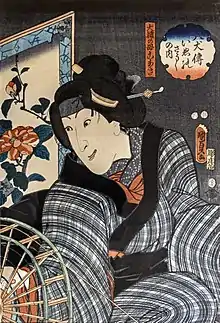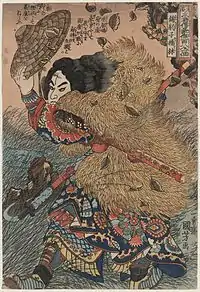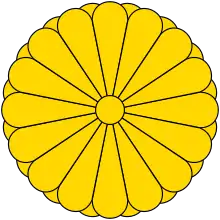Nansō Satomi Hakkenden
Nansō Satomi Hakkenden (shinjitai: 南総里見八犬伝; kyūjitai: 南總里見八犬傳) is a Japanese epic novel in 106 volumes by Kyokutei Bakin. The volumes were written and published over a period of nearly thirty years (1814–42). Bakin had gone blind before finishing the tale, and he dictated the final parts to his daughter-in-law Michi. The title has been translated as The Eight Dog Chronicles,[1] Tale of Eight Dogs,[2] or Biographies of Eight Dogs.[3]


Plot and influences

Set in the tumultuous Sengoku period (350 years before Bakin lived), Hakkenden is the story of eight samurai half-brothers — all of them descended from a dog and bearing the word "dog" in their surnames — and their adventures, with themes of loyalty and family honor, as well as Confucianism, bushido and Buddhist philosophy.
One of the direct inspiration sources of the novel is the fourteenth to seventeenth-century Chinese epic novel Water Margin by Shi Nai'an. Japanese translations date back to at least 1757, when the first volume of an early Suikoden (Water Margin in Japanese) was printed.[4]
Bakin dramatically increased his popularity and fame with the novel Chinsetsu Yumiharizuki (Strange Tales of the Crescent Moon , 椿説弓張月) which he began publishing in 1807, helped by Hokusai's imaginative and powerful illustrations. However, due to the difference of opinion on the illustration, the collaboration ended with seven works. For Hakkenden, Hokusai's son-in-law, Yanagawa Shigenobu was employed as illustrator instead.
A complete reprinting in ten volumes is available in the original Japanese, as well as various modern Japanese translations, most of them abridged. Previously, only a few chapters had been translated into English, Chapter 25 by Donald Keene and Chapters 12, 13, and 19 by Chris Drake. A full translation is currently in progress and is available on the Internet.
History of reception
Hugely popular at the time of publication and into the early twentieth century, Bakin's work lost favor after the Meiji Restoration, but came back into fashion later in the twentieth century.
In live-action film and TV there have been numerous adaptions: the first in 1938, then a series in the 1950s, and since the influential TV series Shin Hakkenden (ja:新八犬伝) from the early 1970s, every decade has had either a live-action adaptation or a show significantly influenced by the novel, right up through the 2010s.
The novel has also been adapted into kabuki theatre several times.[5] In August 2006, the Kabuki-za put on the play.[6] In 1959, the TOEI motion picture company made Satomi hakken-den.[7] In 1983, the novel was loosely adapted into the film Legend of the Eight Samurai.
Hakkenden has had a strong influence on modern manga and anime works, particularly those based on adventure quests. For example, it influenced Akira Toriyama's Dragon Ball (1984) and Rumiko Takahashi's Inuyasha (1996), which both have plots about the collection of magical crystals or crystal balls.[8]
References
Citations
- Shirane, Haruo (2002). Early Modern Japanese Literature: an Anthology, 1600-1900. Columbia University Press. p. 886. ISBN 0-231-10990-3.
- Rimer, J. Thomas (2007). The Columbia Anthology of Modern Japanese Literature: From Restoration to Occupation, 1868-1945. Coughlan Publishing. p. 196. ISBN 0-231-11861-9.
- Keene, Donald (1955). Anthology of Japanese Literature, From the Earliest Era to the Mid-Nineteenth Century. Grove Press. p. 423. ISBN 0-8021-5058-6.
- Shirane and Brandon, Early Modern Japanese Literature, p564.
- "Nansô Satomi Hakkenden". kabuki21.com. Retrieved 3 March 2018.
- Satomi hakken-den at IMDb
- Papp, Zília (2010). Anime and Its Roots in Early Japanese Monster Art. Global Oriental. p. 38. ISBN 978-90-04-20287-0.
Works cited
- ^ Kyokutei Bakin (1819) "Shino and Hamaji". In Keene, Donald (Ed.) ([1955] 1960) Anthology of Japanese Literature: from the earliest era to the mid-nineteenth century, pp. 423–428. New York, NY: Grove Press. ISBN 0-8021-5058-6
- ^ Kyokutei Bakin (1819) "Fusehime at Toyama Cave," "Fusehime's Decision," "Shino in Otsuka Village," "Hamaji and Shino". Translated by Chris Drake in Haruo Shirane (Ed.) (2002) Early Modern Japanese Literature: An Anthology 1600–1900, pp. 885–909. New York: Columbia University Press. ISBN 0-231-10991-1
Further reading
- Hamada, Keisuke (1983). "Nansō Satomi Hakkenden". Nihon Koten Bungaku Daijiten 日本古典文学大辞典 (in Japanese). 4. Tokyo: Iwanami Shoten. pp. 571–573. OCLC 11917421.CS1 maint: ref=harv (link)
- Keene, Donald (1999) [1993]. A History of Japanese Literature, Vol. 2: World Within Walls – Japanese Literature of the Pre-Modern Era, 1600–1867 (paperback ed.). New York, NY: Columbia University Press. ISBN 978-0-231-11467-7.CS1 maint: ref=harv (link)
External links
| Wikimedia Commons has media related to Nansō Satomi Hakkenden. |
- Original text of Nansō Satomi Hakkenden, first 30 chapters as of 2006 (Japanese)
- The Hakkenden Hakuryu-Tei website and the complete Japanese version
- ^ The Legend of the Eight Samurai Hounds, English translation in progress since September 2015

